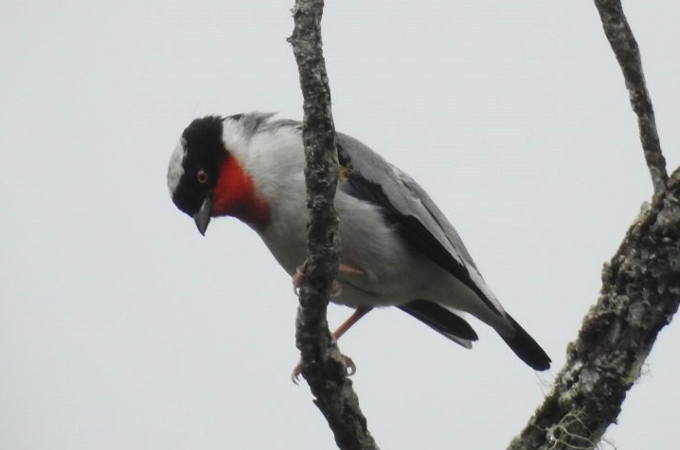Scientists eavesdrop on a South American forest to find a missing bird

How do you look for an animal you don’t even know exists anymore?
The last sighting of the purple-winged ground dove (Paraclaravis geoffroyi) — a small, bamboo-loving dove native to the South American Atlantic Forest in Brazil, Argentina and Paraguay — was in 1985. But, researchers wondered, was it possible to capture the elusive bird’s sound in the wild to find out if any individuals are left?
It’s not an unheard-of idea. Scientists have used bioacoustics — a subfield of ecology that relies on sound to make environmental analyses — for everything from recording dolphins’ communication patterns to studying bats from afar to avoid virus spillover from humans (SN: 12/7/17; SN: 10/23/22). With artificial intelligence, it is now possible to use large audio datasets to train algorithms to spot different animal sounds within the cacophony of a natural background.
But the problem is that recordings of the purple-winged ground dove singing are as rare as the bird itself.
“I came across [the bird’s song] watching a 1985 interview with Carlos Keller, a former bird breeder in São Paulo state, who had a few individuals of the dove,” says Carlos Araújo, an ecologist at the Instituto de Biología Subtropical at the Universidad Nacional de Misiones in Argentina. “And they sang while he spoke.”
With Keller’s help, Araujo and colleagues accessed the decades-old recording and isolated the bird’s song.
The next challenge was to see if it was even possible to identify individual bird songs amidst the sounds of other birds chirping, leaves rustling, rain falling, insects whirring and gnawing and larger animals moving through the forest.
“We took a step back and did some analyses with other birds that are critically endangered but there are known individuals,” Araújo says. The team focused on three species found in Foz do Iguaçu, a national park that straddles the border of Brazil and Argentina: the cherry-throated tanager (Nemosia rourei), the Alagoas antwren (Myrmotherula snowi) and the blue-eyed ground-dove (Columbina cyanopis). These birds live in the same environments as the purple-winged ground dove. And the blue-eyed ground dove’s story inspires hope: The species went missing in 1941 and was rediscovered in 2016.

The researchers installed 30 recorders in strategic spots along green areas in the Brazilian part of Foz do Iguaçu and recorded from July 2021 to April 2022. They also used data from another 100 recorders on the Argentinian side of Foz.
“We went looking for the Guadua trinii bamboo to place the recorders,” says Benjamin Phalan, Head of Conservation at Parque das Aves, a private institution in Foz do Iguaçu focused on the conservation of Atlantic Forest birds. Like the purple-winged ground dove, the three bird species follow the flowering season of the G. trinii bamboo, which happens about once every 30 years.
The team pushed through thickets of bamboo, braved ticks and biting flies, and watched out for venomous snakes such as jacaracas pit vipers. Bumping into these snakes is “rare but can happen. So we use galoshes or gaiters to protect us in case anyone steps on a snake or near it,” Phalan says.

The recorders captured one minute of landscape sound every 10 minutes and generated about 3,000 days’ worth of recordings. “A lot of data to sift through,” says Araújo.
Readily available analysis software wouldn’t work. These software, Araújo says, “need a lot of data input. With such rare species, we just don’t have that much data to train the identification algorithm.”
So the team started from scratch, working with the little data they had for the three endangered birds. First, Araújo created a signal template — exactly like the birds’ singing — based on just a few recordings. The algorithm then compares that template with the soundscape recordings, separating signal from noise. If it spots a sound that is similar to the template, chances are that it is the bird that the researchers are looking for.
The method relies on a statistical model “that is not new, but was used in a very clever and unusual way,” says David Donoso, an ecosystem ecology researcher at the Technische Universität Darmstadt in Germany. Donoso and colleagues recently used bioacoustics to investigate the recovery of Choco, a biodiversity hot spot in Ecuador that had been transformed in an agricultural area.
There are different approaches to bioacoustics depending on what you’re looking for, Donoso says. “You can either use fewer recordings to map a whole animal soundscape to tell what species are there, like we did, or you can use lots of recordings to look for a single sound pattern,” he says. The study at Foz do Iguaçu “shows that you can use a relatively simple model to answer a complex question — and it works.”
The tool worked reasonably well to identify the cherry-throated tanager and blue-eyed ground-dove singing, but not so much for the Alagoas antwren, Araújo’s team reports October 23 in Bioacoustics. “We’re trying to understand what happened, but we know that the algorithm works,” he says.
The next step, Araújo says, is to refine the algorithm’s precision to find the Alagoas antwren and train it to look for the purple-winged ground dove. And they will do so at the same time. “We’re aiming at both goals at once because we’re running against the clock to find these birds,” Araújo says. “In the end, we are looking for a ghost.” But not a silent one, he hopes.
Source



